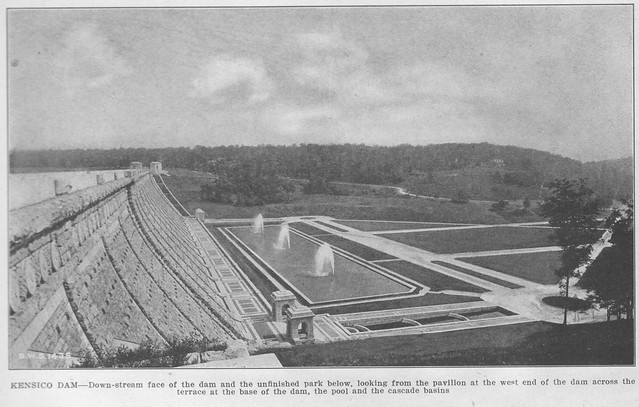
Home > NYC Reports > 1917
For most of 1917 Catskill water was delivered to the five boroughs of New York City continuously, and the first phase of the project including the Kensico Reservoir was officially considered complete. The project was completed more than a year ahead of schedule and about $7M under budget.
Although the photo’s caption still refers to the plaza as unfinished, it’s a lot further along than what was shown in a similar photo in 1916. The large pool in front of the dam is now filled with water and contains three fountains. I don’t think the fountains survived for very long, but the pool is still filled with water to this day. Preliminary plans for eventual landscaping in the plaza were begun in 1917.
Another picture of the dam from below. In this picture the fountains are described as ‘experimental jets’.
The lack of trees on the hill makes the dam appear larger than it does today. It looks like there may be water in the pool in front of the lower west pavilion. Those pools on the east and west side are no longer used.
There is definitely water in the identical pool on the east side, called a cascade in the photo caption. It’s a shame the fountains at the top of the cascade weren’t actually running when the picture was taken. It would have been nice to see what it looked like in full operation. Still the nice, new, clean structure is mighty grand.
The same area as above but showing the full visible height of the dam. The original caption says this shows details of the architectural design and the rugged character of the stonework in keeping with the massiveness of the structure. Well said.
During the year roofing was added to the influent and upper effluent chambers on the west side of the reservoir. The contractor responsible for construction of these building in general ran into financial difficulties during the year and was unable to complete the contract. The remaining valves and sluice gates were added to the chambers during the year as were heating systems. The remaining tree planting around the reservoir was also completed in 1917. Also completed during the year was the brick paving of East Hill Drive on November 5. I believe the brick is still visible today. At the aerators 62% of the brick surface was laid.
The influent chamber and weir where water flows from the aqueduct into the reservoir. The weir is basically a slot in the aqueduct. When the gates are open, the water flows into the by-pass aqueduct. Closing the gates causes the water to back up and flow over the weir into the reservoir.
Home | 1916 Report | 1918 Report | Site Map
Synopsis written by Robert Mortell, 2013.